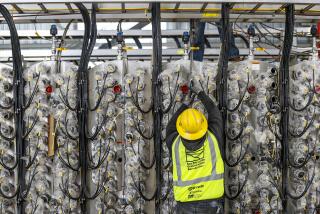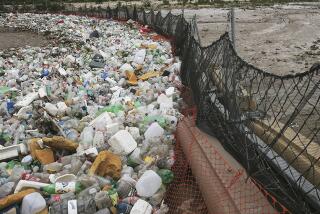Cerritos Taps Into Reclamation : ‘Waste’ Water for a Green City
CERRITOS — Just off the 605 Freeway lies an oasis of sorts, a place of water and the sounds of water. There are large pools, noisy falls and churning channels. It is a logical spot to look for water to feed the sprinklers that keep this city’s abundant parkland unnaturally green.
So that is where city officials have turned, undaunted by the fact that the oasis is a sewage treatment plant that handles 35 million gallons of unsavory waste water a day.
Since November, workers have hooked up 22 miles of underground pipeline that snakes around the city, running from the Los Coyotes Water Reclamation Plant to the irrigation systems that water the City Hall complex, public schools, parks, and Cerritos College. By early March, when the hookups are expected to be completed, the city will have cut its consumption of drinking water by about 8%, using instead salvaged sewage water that otherwise would have flowed into the sea.
After years of planning, the city’s $8.5-million water reclamation system will place Cerritos among the state’s biggest consumers of recycled waste water. The city joins an estimated 200 California communities--including Long Beach, Pomona and Irvine--that are tapping into sewage plants for irrigation water.
Demand Rises
Although the move to use waste water is growing at a trickle, it continues to gain momentum as water demand rises and the cost of developing new water sources escalates. “Water reclamation is becoming more and more viable,” observed Richard Mills, an engineer with the state Water Resources Control Board, which gave Cerritos a $4.5-million grant to help build the local system.
Without the state money, city officials say they never could have afforded the irrigation network, even though the reclaimed water will cost about a third less than drinking water. It will take 25 years for the city to break even on its half of the project, which involved installing an elaborate pumping station at the treatment plant as well as laying underground water mains.
“The whole intent of the project is to save potable water,” said Bill Morris, director of the city’s Public Services Department.
Because Cerritos is a relatively young community, it came in at the tail end of the water rights game in the Los Angeles basin. Morris said the city has rights to pump only about a third of the ground water it needs to satisfy all of its residential and commercial needs. The rest must be purchased from the Metropolitan Water District. Every gallon of drinking water saved thus reduces the city’s dependency on the district’s supplies.
“If there’s ever a drought, we’ll probably be the only green city around,” Morris said. That is no small matter in a community that enjoys about twice as much parkland per resident as the average city.
Offered to Other Cities
With the exception of a few out-of-the-way spots, all of the approximately 350 acres of Cerritos land will be irrigated by the new system, along with public school grounds, freeway banks and the local community college. The city also has approached neighboring communities about tapping into the system along their borders, where it would be economical for them to hook into the irrigation pipes. Morris said Lakewood will take some water for a couple of its parks, and discussions are under way with La Mirada, Norwalk and La Palma.
Cerritos has for years been experimenting with reclaimed water on a limited basis. The links of the city’s Iron Wood Nine Golf Course, located next to the sewage plant, have been kept lush with treated waste water since 1977.
Morris said the golf course has proven the treatment plant to be a reliable--and safe--water source. Soil samples have turned up nothing undesirable. To the contrary, he said, nitrogen from the processed sewage water has saved the city about $300 a year in fertilizer costs.
Samples Look Clean
Workers at the treatment plant swear by the plant’s effluent, holding up samples to show off how clear and clean-looking it is. At the city dedication of the irrigation system last weekend, a pail of the treated waste water was dumped over Morris’ head.
The plant takes commercial and residential sewage from a number of Southeast-area cities, and puts it through a sophisticated, three-step purification process that gives the foul liquid a new life. What was filthy and unsightly emerges free of bacteria, odor and much of its discoloration.
The effluent is approved for public contact, if not drinking, and the water flowing into the city’s irrigation system will not receive any additional treatment or testing.
If a child or a dog runs under the sprinklers, it won’t be a problem, officials say.
More to Read
Sign up for Essential California
The most important California stories and recommendations in your inbox every morning.
You may occasionally receive promotional content from the Los Angeles Times.











